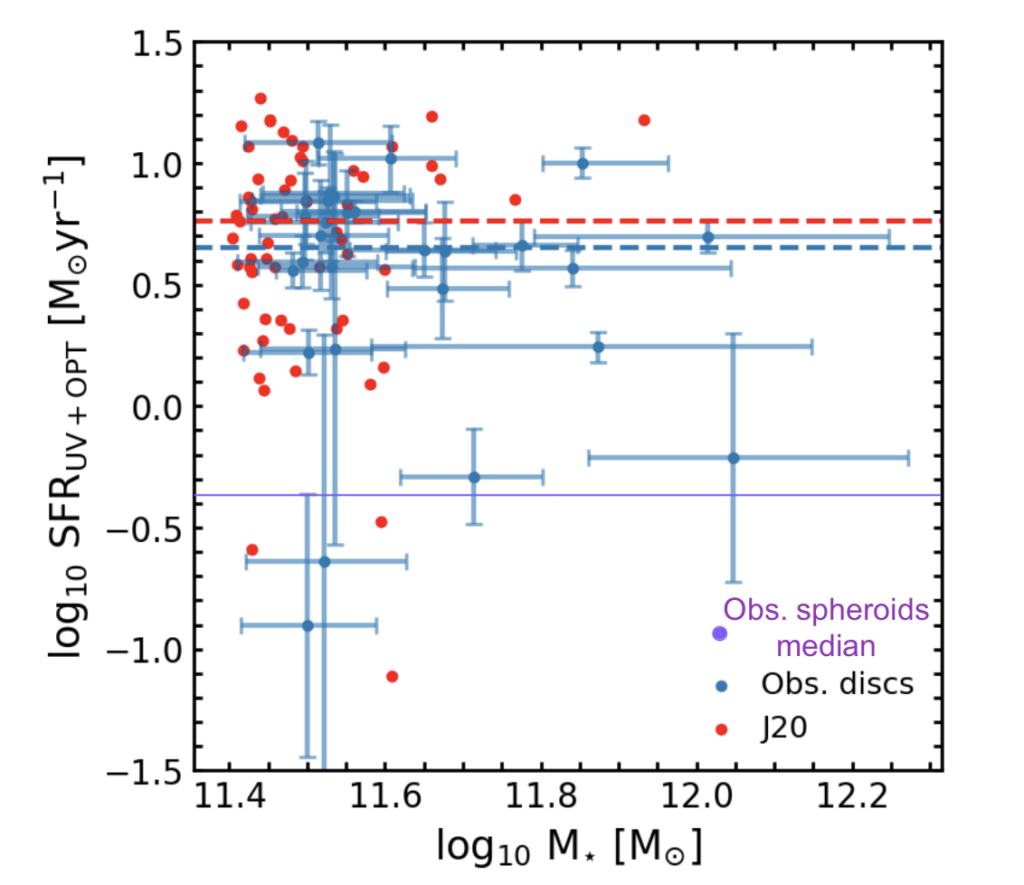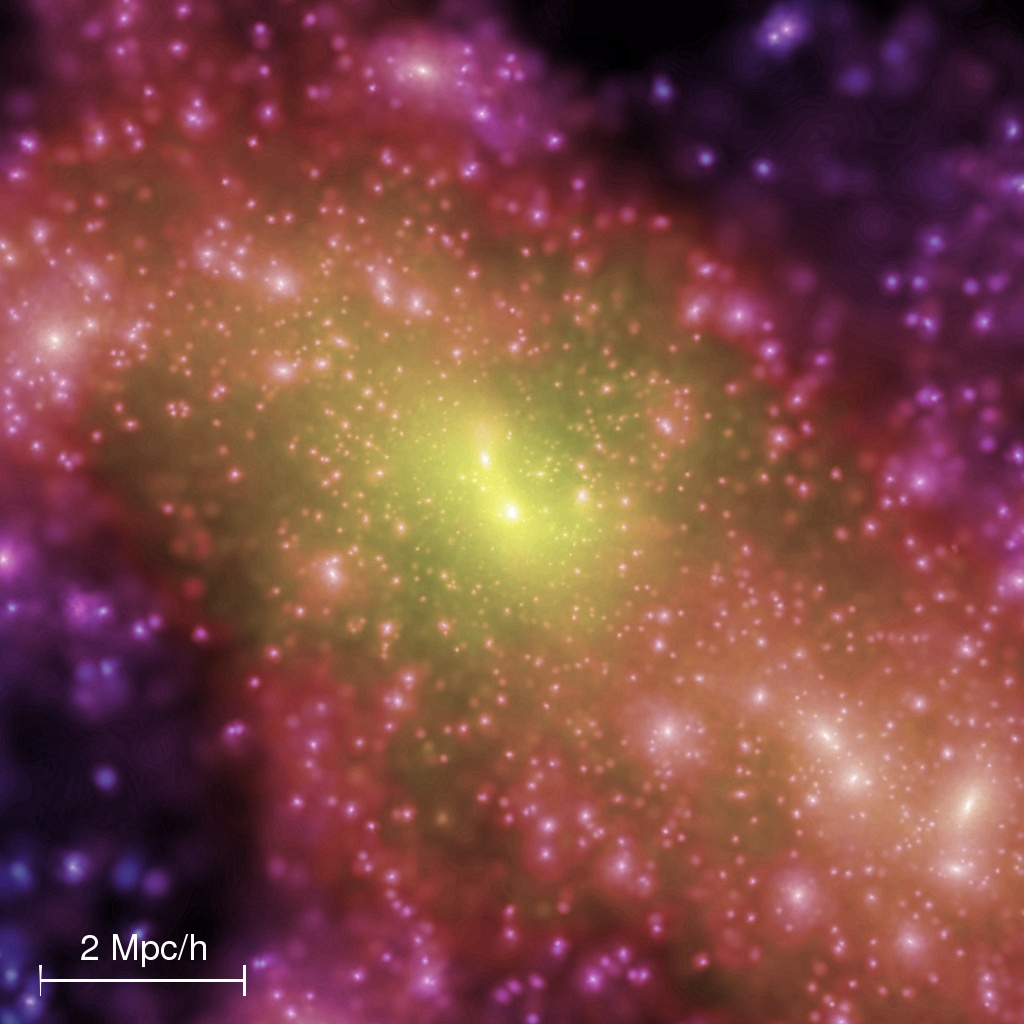Title: Extremely massive disc galaxies in the nearby Universe form through gas-rich minor mergers
Authors: R. A. Jackson, S. Kaviraj, G. Martin, J. E. G. Devriendt, E. A. Noakes-Kettel, J. Silk, P. Ogle, Y. Dubois
First Author’s Institution: Department of Astronomy and Yonsei University Observatory, Yonsei University, Seoul 03722 Republic of Korea
Status: Published in the MNRAS [closed access]
While massive galaxies don’t look any different from day to day in a mere human lifetime, if you looked at them many billions of years into the future, you might not even recognize them. In their infancy, most of them were small, tidy disks (AKA spiral galaxies) with the majority of their stars rotating in one direction. But as they engaged in complex dances with other galaxies, sometimes crashing into each other and merging, these galaxies would grow and their tidy structure becomes disrupted, with their stars leaving their ordered rotational orbits and starting to move in random directions. Most galaxies that we call spheroidal or elliptical today are dominated by such random motions, with no clear rotation direction. The only way for them to grow so large seems to be through major mergers with other similarly-sized galaxies, a process which tends to destroy disks, therefore we expect massive galaxies today to be spheroidal in nature.
While this chaos of mergers is thought to be the main path to growing massive galaxies, we have found a significant minority of massive galaxies today that actually exhibit a disky morphology instead of a spheroidal one! How did these giants survive mergers with other galaxies while also growing to their enormous sizes?
Let’s Put our Theories to the Test
The authors of today’s paper have been keen to answer this question for some time now. Since we can’t just sit back and watch galaxies grow, they first addressed this conundrum in a previous paper using simulations to predict two main ways in which extremely massive disk galaxies are created (and we have an Astrobite about it!). They found that these behemoths formed most commonly by a merger between a massive spheroid and a much smaller satellite galaxy (a so-called “minor merger”) that can bring in a lot of gas into the system and “spin up” the stars in the galaxy, causing them to tidy up and rotate in the same direction again. In a few less common cases, the galaxy could have just simply had an unusually quiet merger history that let it retain its gas and disk. In today’s paper, they put their theories to the test to see if the predictions from their simulations hold true observationally.
With data from four different surveys– SDSS, DECaLS, GALEX, and ALFALFA– the authors constructed a catalog of 708 massive (>1011.4 Msun) galaxies at redshifts comparable to the galaxies in their simulations (0.03<z<0.1). Their first step was to classify these galaxies as either disks or spheroids, which they did painstakingly by eye. They also flagged any tidal features like tails, plumes or anything that indicates the galaxy has been disturbed or has interacted with another galaxy in its past. Examples of both types of galaxies, with and without tidal features, are shown in Figure 1.

The sample ended up being 13% disk galaxies, with 64% of those having tidal features, much higher than the corresponding value of 31% for spheroids. This indicates that many more of the disk galaxies underwent recent mergers than the spheroids, since the fraction of tidal features in those galaxies is about 4 times higher than that of spheroids. Since tidal features fade away after some time, we can infer that most spheroids merged at a higher redshift (and hence a longer time ago) than their disky counterparts. That said, these were most likely not major mergers, but rather minor ones that are much more frequent. This is because a sample of massive galaxies like these undergoes very few major merger events in this low redshift range, so a series of more frequent smaller mergers must have occurred to create so many disk galaxies with tidal features. These results are consistent with their simulations, which showed that 11% of their massive galaxies were disks, and that these galaxies merged more recently than spheroids.
Saying HI to Stellar Friends
The authors also looked at the star formation rate (SFR) of these galaxies. If their simulations were correct and most massive disks were formed through collision with gas-rich satellites, then these galaxies should have had a lot of gas to feed on to create stars, leading to a higher SFR. And this is indeed what they found! In Figure 2, you can see the SFR for observed and simulated disks in blue and red, respectively. The blue dashed line shows the median SFR for observed massive disks, while the solid purple line shows the median SFR for observed spheroids. As expected, the median SFR of disks is significantly higher than that of spheroids.

Going one step further, we can actually estimate how rich a disk galaxy is in gas that it can use to form these new stars. Places that have a lot of gas like neutral atomic hydrogen, HI, are ripe for star formation, so the authors look at four disk galaxies that have HI detections in the ALFALFA survey. Out of these four, only one happens to have tidal features. They found that the disturbed disk has a larger HI mass and HI fraction than the other relaxed disks. This meshes well with our idea that a merger will deposit gas into the galaxy and leave a tidal feature. Over time, this gas gets used up to form stars while the tidal feature slowly fades away. The authors also estimated that if a satellite did indeed merge with the disturbed galaxy, then it would have an HI fraction anywhere from 39-76%.
Though their estimates of HI gas mass and gas fraction should be taken with a grain of salt since they only had four galaxies to work with, all of these clues–the fraction of disks vs spheroids with tidal features, star formation rates, and HI properties–point to the idea that these anomalous massive disk galaxies are formed by minor mergers of a spheroid with relatively massive gas-rich satellites. This paper is a great example of how scientists can use both simulations and observational data to take a glimpse into our universe’s past and learn how galaxies grow.
Astrobite edited by Olivia Cooper
Featured image credit: Jackson, R. A., et al. “Extremely massive disc galaxies in the nearby Universe form through gas-rich minor mergers.” Monthly Notices of the Royal Astronomical Society (2022).




